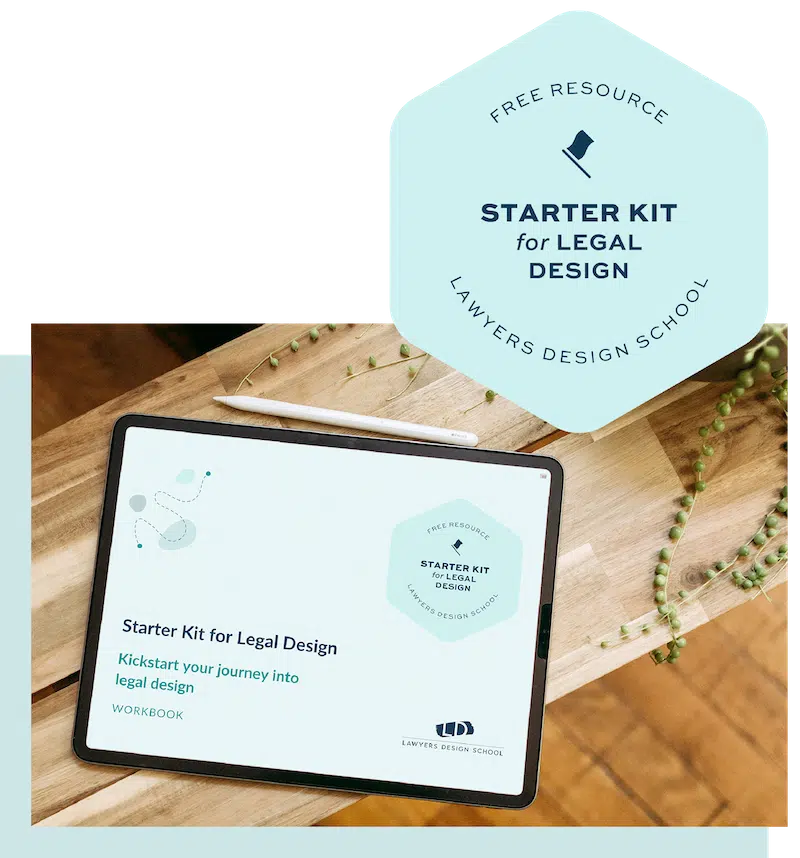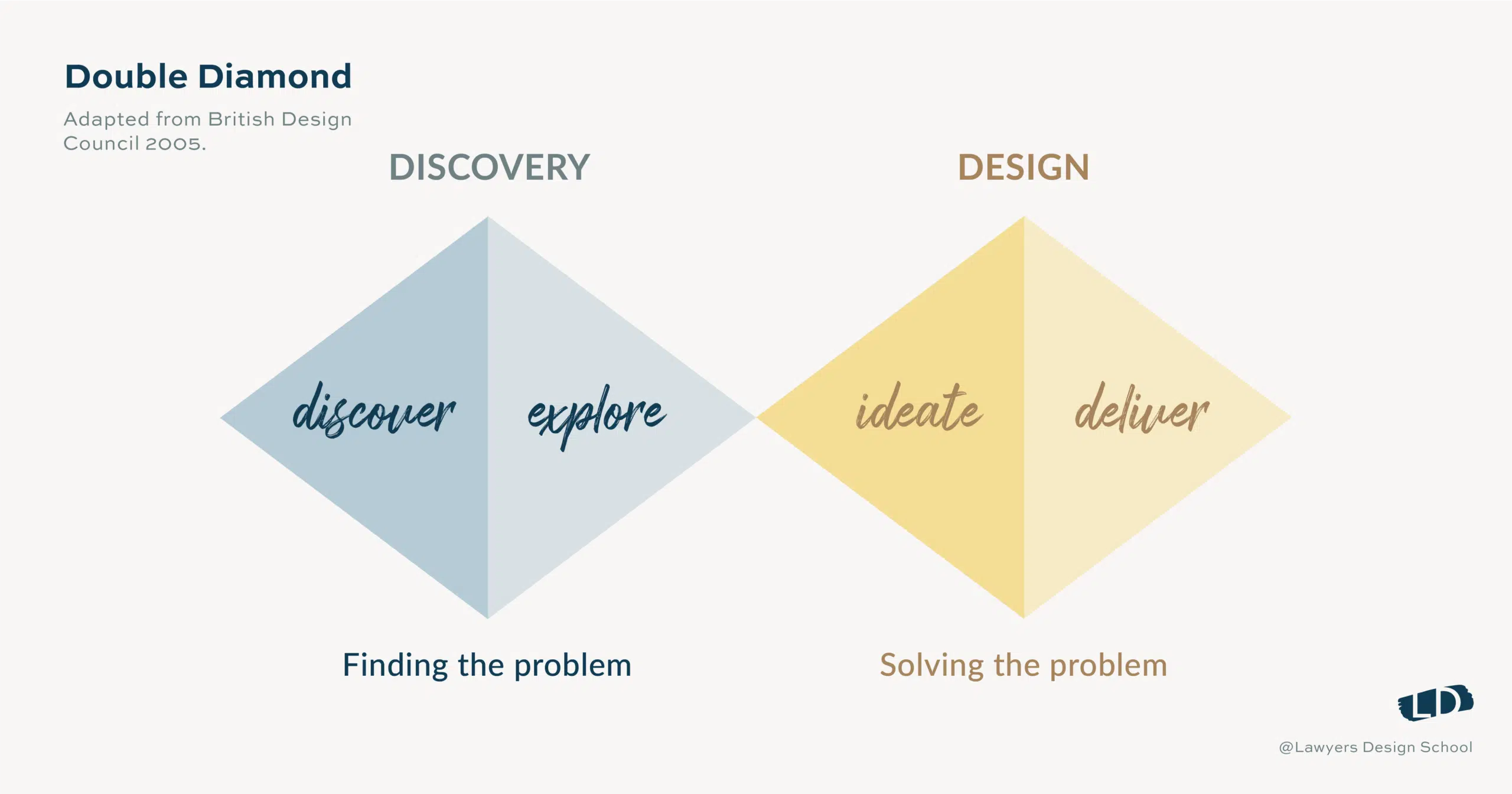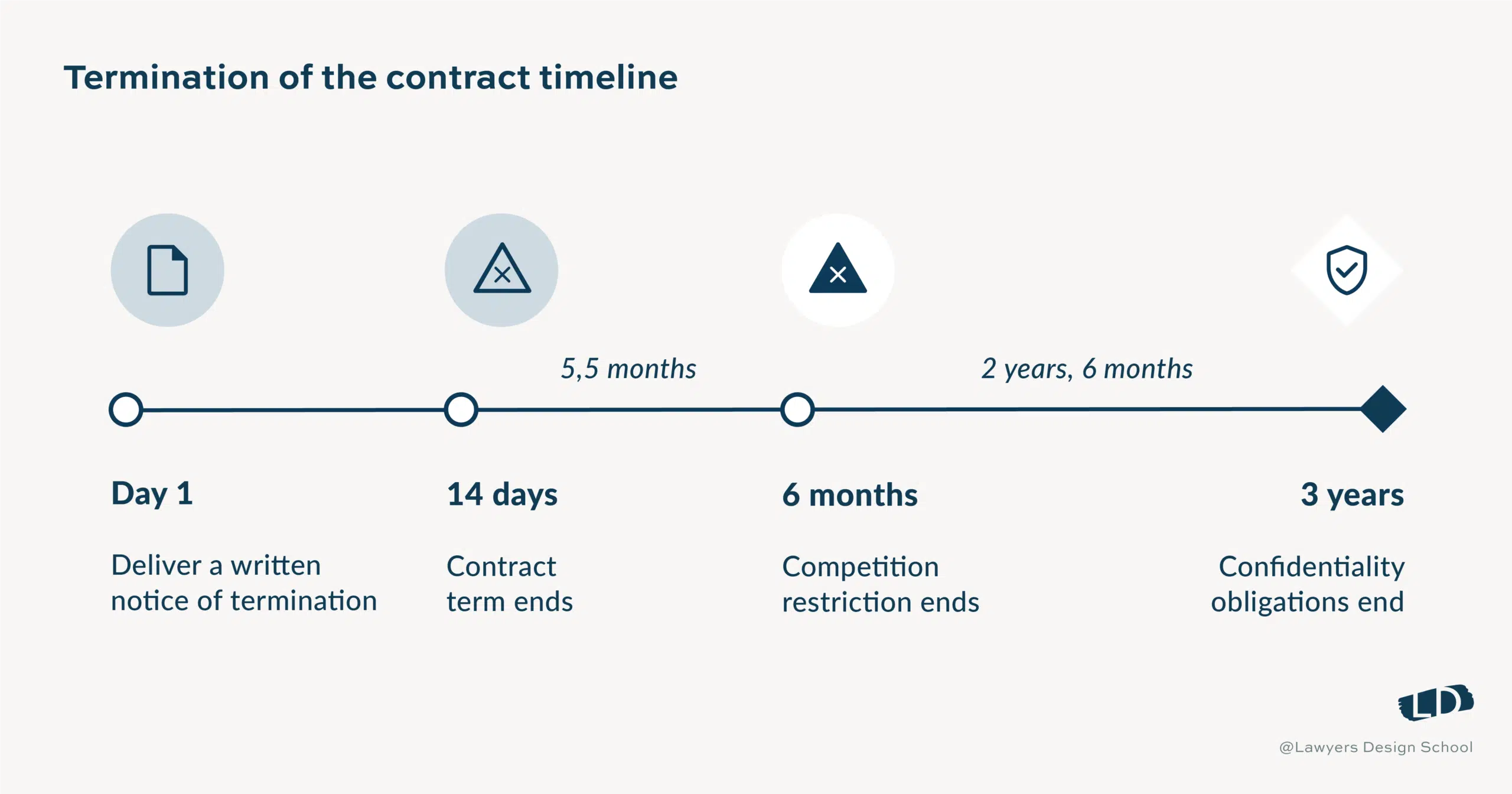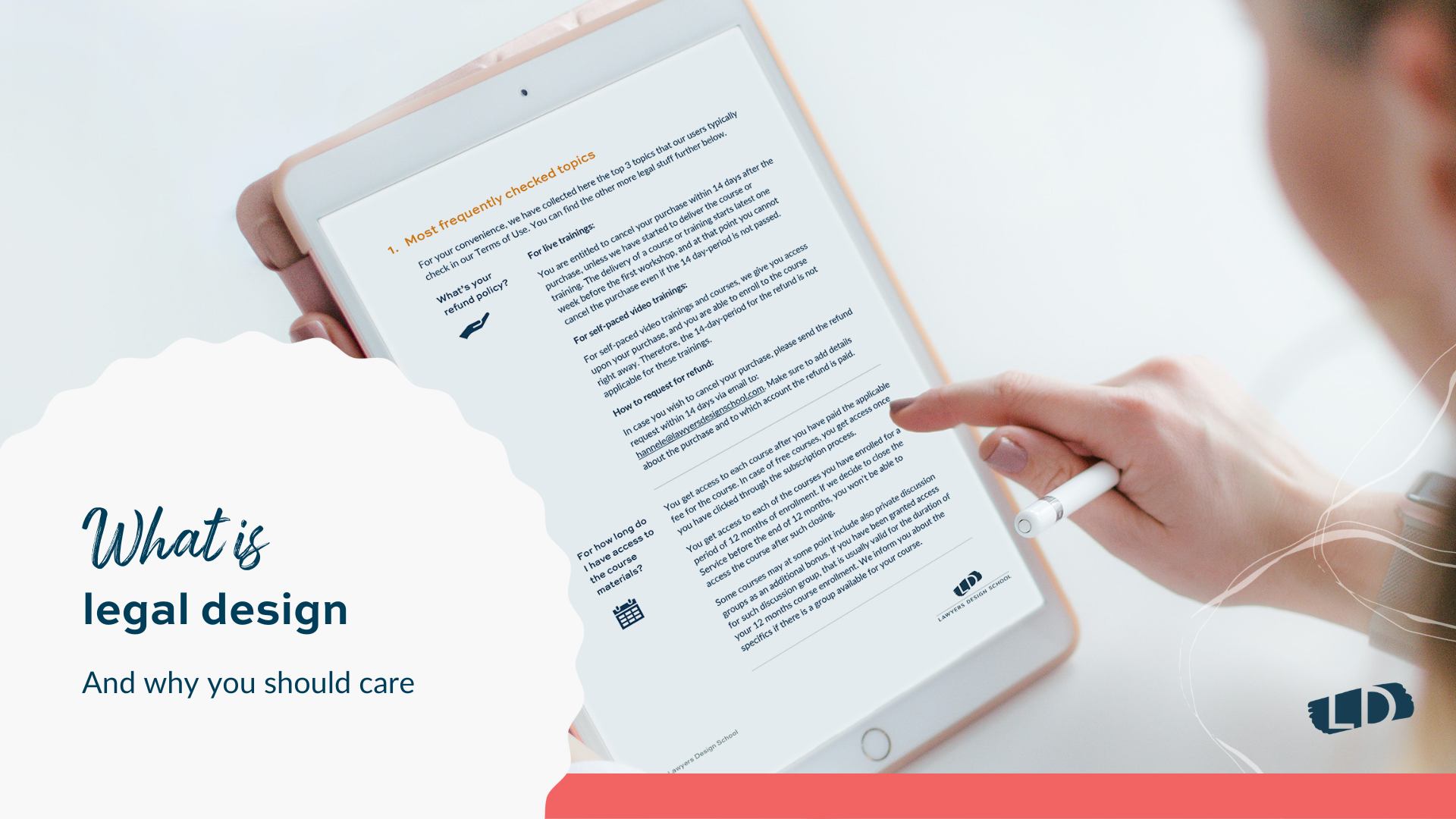Legal design is a consistent process, mindset, and practical toolbox empowering lawyers and other legal professionals to intentionally design legal products, services, and systems that make the law more human, accessible, and understandable to users.
The foundation of Legal Design is the customer experience. Designerly lawyers ask one question before they jump to the solution. “Do I understand what’s truly going on with my customer? Is this the best way to communicate the information or the services they need?”
Instead of approaching the practice of law the traditional way, Legal Design requires lawyers to look at issues with a fresh perspective and deliver legal solutions and contract information that empower, instead of confusing customers. It’s human-centered design.
Why is Legal Design important for lawyers?
Legal design is important because the system, legal documents and legal concepts are complicated. It’s about lawyers, not consumers.
- It transforms our complex, confusing and expensive legal system and makes it accessible to everyone.
- Legal Design provides the process for customer-centric legal services. Lawyers are no different to other service providers.
- It can stop lawyers from leaving the law. It’s a sustainable law approach that removes the competitive culture, the churn and allows firms to prepare for the future.
- It’s the way to comply with government requirements for user-friendly legal documentation. The GDPR requires privacy policies to be user-friendly and understandable, for example.
- It gives attorneys and legal businesses the tools to speed up innovation in law and find better, faster, more efficient ways to serve and work.
- And finally, the profession is embracing a design approach to law. Law Schools and Universities are adding the design process to their syllabus. Businesses like Lawyers Design School are showing lawyers how to use Legal Design thinking, Contract Design, information visualization, plain English and legal tech to change how we do law.
The legal design movement and legal innovation are here.
What is Legal Design?
Legal Design is about building a better user interface for the law. It can develop better, more user-friendly and accessible legal systems, legislation, organizations, legal services, technology and information.
Because the legal system affects everyone, accessing equal rights and justice is essential. Legal Design is about simple, user-friendly and inclusive communication between lawyers and customers. It is a partnership where designerly lawyers don’t assume what customers need. They take the time to understand the customer’s needs and then deliver the solution.
Human centricity and empathy are at the heart of Legal Design. These words are not traditionally associated with the law. Lawyers Design School will make the law accessible and give lawyers meaning in their work. The legal profession must evolve.
Why should law firms and in-house teams use legal design
1. Reduces time and cost pressure for lawyers
Lawyers are busy. In-house lawyers are rushing to accomplish more work in less time with fewer resources.
Legal Design tools help lawyers and in-house teams identify inefficiencies in legal workflows. By streamlining and improving processes, design thinking processes allow in-house teams to save time and achieve more.
Legal Design focuses on user-centric solutions, simplifying complex legal documents and communications, which can reduce time spent on clarification and revisions.
2. Elevates in-house teams to strategic partners
In-house legal teams perform routine work in support roles.
Legal design allows lawyers to be the voice of the customer and become strategic partners in service delivery and profitability. Every customer journey within any organization culminates in a contract. As the lawyers responsible for these contracts, they learn the challenges and objections customers face when engaging with attorneys. These questions can relate to pricing models, service levels, and warranties. They are not only legal but also very strategic.
In-house teams and lawyers can be proactive and propose initiatives. Legal professionals who learn “customer speak” can translate legal issues into customer issues and highlights how the customer experience impacts the business and can harm the business performance. This unique understanding is something that only lawyers possess. The non-legal business units leave contracting to in-house teams. Legal teams can make that knowledge work in their favor.
Claiming this role gives lawyers a seat at the table early. They can raise all the issues and address them before they become problems. It improves the reputation of the business and firm through heightened service and customer referrals.
Legal Design promotes a more strategic approach by integrating legal professionals into the decision-making from the beginning. By involving legal teams early on, Legal Design enables in-house teams to contribute expertise, identify risks, and provide guidance on strategic initiatives. This shift allows legal teams to have a seat at the table. It’s great for business.
3. Increases capacity for innovation
Legal professionals want to improve the way they work. But they don’t know how to innovate and implement the innovation in their services.
Legal Design provides a structured approach to innovation, offering tools and methodology to innovate with creative solutions. The Legal Design process, including discovery, ideation, prototyping and user testing, can be applied to redesign processes and how lawyers work. Legal Design encourages experimentation and iterative improvement, helping overcome barriers to innovation.
When legal work is faster, more rewarding and more strategic, lawyers enjoy work and serve consumers more effectively.
4. Empowers the business to take ownership of legal matters
In-house legal departments exist in a silo. There is a perception that legal and compliance matters solely belong to the legal team, leading to less engagement, and understanding from other departments.
Legal Design promotes a culture of legal empowerment by creating user-centric legal solutions. It encourages collaboration and engagement between legal teams and other departments, breaking down barriers.
Through user-friendly legal documents and plain legal language, Legal Design can bridge the gap between complex legal content and help non-legal professionals understand documents. It instills a sense of shared responsibility for legal matters, empowering the business to take ownership and be actively involved. When internal clients understand their legal documents, they can do their jobs without ongoing legal assistance which frees up the in-house team for a more strategic partnership in the business.
5. Reduces the resistance to change
It is difficult to break away from established routines and embrace new ways when it directly affects day-to-day tasks.
Legal Design reduces resistance to change because it involves stakeholders in the process. By engaging colleagues, their perspectives and insight are valued and incorporated into the solutions. This participatory approach fosters a sense of ownership and increases acceptance. Legal Design emphasizes the importance of effective communication and collaboration, enabling smoother transitions.
6. It increases revenue for legal businesses
Clients don’t look forward to seeing a lawyer.
Lawyers cannot fully understand users’ emotional, intellectual, social and physical needs because our services are lawyer and system-centric. The legal system and information are created by lawyers, for lawyers. The courts and the legal system are baffling to an outsider. Lawyers have the power.
When we build our legal processes around the customer experience, legal information, services, products, and transactions are transparent and understandable. This bridges this gap creating trust and loyalty, and can grow your client base and give your business and competitive advantage.
It starts with asking your users what they find difficult about dealing with you.
7. Lead with your values
Legal Design offers a tangible tool for legal leaders to lead with values. A Harris Poll commissioned by Google Cloud in 2022 found 82% of American consumers buy from brands with values aligned with their own. The design toolkit and framework are ideal for in-house teams and law firms to examine what they stand for.
- Define the core values of your business in collaboration with your entire team.
- Manifest your values in your daily work.
- Let go of the old legal ways that don’t work for you.
“In the past jobs were about muscles, now they’re about brains, but in the future, they’ll be about the heart.”
Dame Minouche Shafik
8. Stop lawyers from leaving the law
Baby boomers are retiring, and a new generation of lawyers has arrived. They are Gen Z lawyers.
I wrote a blog two years about “quitting the law”. That search term drives a lot of traffic to this website. True story! Lawyers want to leave the law.
Who will lead the legal profession into the future if lawyers want to leave?
Gen Z lawyers have different expectations about life and a career in the law. Deloitte’s report on Understanding Generation Z in the Workplace describes Gen Z as realists with a vision for a better world for everyone.
I’m not sure Gen Z lawyers will tolerate the traditional “rite of passage” in law, where long hours, lawyer burnout, and competition reign supreme. Legal Design can transform the work of lawyers and legal teams and create a new legal culture. The skills lawyers need in the future are changing. Legal Design thinking is one of them.

STARTER KIT FOR LEGAL DESIGN
Free resource
Get this free resource to kickstart your journey into legal design.
Add empathy, simplicity, and creativity to your legal work and elevate customer experience.
How does legal design work?
Margaret Hagan brilliantly describes Legal Design as getting a new pair of glasses to look at the world.
The new glasses put the lens on our customers instead of our lens as lawyers or the systems we work within.
We use the glasses to ask how we can deliver legal services the best way so they are user-friendly, satisfying and increase engagement. We peel back the layers: our mindsets, processes, and systems, then examine every aspect to find the best way.
Legal design is not about making pretty documents
It’s drilling deep into the core needs of our customers, designing processes, customer experiences and solutions to reflect those needs.
We design information for customers
All customers have different needs, and all customers have preferred ways to receive information. Like us, customers want respect, feel empowered by the law, and interact with a peer who will provide options, alternatives and advice without the legalese, the hoops and the barriers protecting traditional law.
We can reimagine legal information using structure, language and visuals that make sense for people.
When email was invented, lawyers scoffed and insisted traditional mail was the only way. Look at us now. We can give information to our consumers in different ways. Our only limitation is our imagination.
How do lawyers start using Legal Design?
Even if you have a day job, you can incorporate legal design into your everyday work and see how it feels. The new pair of glasses may lead you to discover a process or communication style you enjoy and calls you to grow and enjoy it further. Who knows where it could lead?
Our ability to think and innovate are the only limitations.
I like the Double Diamond approach to Legal Design in action. There are two main steps:
Find the problem – discover and define
Discover: use various methods to gain customer insights.
Define: use customer insights and identify the real problem that needs to be solved.
Solve the problem
Ideate and build a prototype: where you ideate many different solutions to the problem and build prototypes.
Test and resolve: where you test your solution with users and resolve the problem.
You’ll struggle with the discovery phase in the beginning. We call it the fuzzy front end of design.

As lawyers, we learn to be action-oriented and dive in and solve the problem. Lawyers are expected to know instead of learning. In design, it’s more important to get curious, listen and identify the right problem to be solved first. Design thinking requires us to fully understand the customer’s needs before deciding the best solution.
It sounds very alien to start, but removing the theory and practicing and actioning is the most effective way to learn Legal Design.We teach Legal Design and Legal Design thinking in our workshops at Lawyers Design School.
What can lawyers do with Legal Design?
Improve your legal services
I recommend starting with your customer experience.
If you want to move beyond the customer-centric and design buzzwords, you need to actually look at the legal issues through your client’s glasses. They might not have the same prescription as you.
When we map we combine all the experiences of your customer on a timeline – the timeline captures what your customer sees and experiences on their journey.
We map their experience in a customer journey map, the service is a process with different phases and we include the service events and touchpoints as the customer sees them. Remember, we are in their shoes or wearing their glasses. Are you comfy?
We must look at the whole service experience:
- Phases before the actual service delivery
- During the service delivery
- After the service
Customer-centric lawyers understand the service in the broader context rather than executing the legal bits.
Think about the journey your customer has had with you. Where do they come from, how do they reach you, and what happens in between? How do they feel at each stage? Understood and heard?
Your likely interaction will be in the typical touchpoints with the customer, a call, meeting, phone conversation or document draft. How you handle those touchpoints is why we map the journey.
Then use the double-diamond approach to design your customer experience. If you’re interested in digging deeper, we teach concrete, actionable, and ready-to-use Legal Design processes at Lawyers Design School. We can even work on your customer experience.

INSIDE TIP: I looked for legal services with three firms recently. I made my decision based on my experience as a consumer. It’s a thing
Create new legal services
As lawyers, we talk to our customers every day, and if you’re anything like me, you chat around the water cooler with your colleagues about better ways to do things. You’re ideating legal innovation daily without knowing.
Legal Design offers lawyers like you the tools to create new legal services and deliver them your way (you know, the way you thought you would when you went to law school.) You could start a new business or side gig. We workshop new legal services at Lawyers Design School, too.
Design better contracts
Contract design is part of legal design. Re-thinking our contracts allows lawyers to communicate with users on levels the users understand.
It also allows legal businesses and lawyers to define their brands and gain a competitive advantage. The legal market is dominated by traditional lawyers obsessed with long contracts and legal letters in 10-font Times New Roman.
What if you were different?
When we design contracts, we aren’t making them pretty. We are making them understandable, engaging and easy to act on. Acknowledging the way legal information is important. It’s not just the legal content.
Designing legal contracts means considering the following things.
- Information architecture
- Plain English
- Layering
- Visualization and visual law
See a real example of contract design in action.

Contract design course
Do you want to learn how to design legal contracts?
Lawyers Design School offers a signature Contract Design School. Over six months at your own pace, change-maker lawyers learn the designerly lawyer mindset and get the framework, the templates and the tools you need to create contracts in a customer-centric way.
Take a look around and see how it feels.
Examples of legal design
Examples of Legal Design are listed below:
- User-friendly websites build for accessibility
- Easy to use court forms and documents
- Legal chatbots
- Redesigned contracts using plain language, visualizations, and layering
- Legal services founded on the customer experience
- Easy to understand legal information
- User-friendly digital legal technology
- Redesigned legal work and processes
- Accessible and inclusive legal system – virtual law firms
Of course, Open AI offers opportunities we’ve yet to imagine.
Examples of legal tech built by design
Legal tech is exploding. Not just legal technology for lawyers – it’s also for clients and for the general public.
Legal tech for clients:
- Online dispute resolution platforms. Every day people can attempt to settle their disputes together online. They access lawyers only if they need one – no more expensive mediation. Clients pay for the product, not the billable hour.
- Automatic online contract generators. Create a company or a contract with a few clicks. Access a lawyer only if it is complex. Clients pay for the product, not the billable hour.
- Online legal advice platforms. Lawyers provide commercial legal advice to individuals and companies for a fixed price.
- Create your own will at home for a fraction of the cost. Again, pay for the product.
- Contract analyzers, with real-time collaborative editing. Plus, powerful analytics for risk management and potential outcomes. Businesses and lawyers can use this software.
- Document (reports, etc.) analyzers. Able to extract key information. Use the data to suggest sound business decisions. Or drive costs down. Discover opportunities and manage risk and regulatory requirements. Again, suitable for businesses and lawyers.
Processes:
- Secure file sharing.
- Case and matter management. Time and billing management. And automated client relationship management systems.
- E-invoicing and signatures – reduce admin and time.
- Encrypted email complying with regulations.
- AI Tech that allows virtual depositions.
Legal tech startups are happening all over the world. They are disrupting our rickety institution. Legal tech is a game-changer. And offers an alternative to working in a traditional law firm.
I chat with a number of legal design pioneers in my Legal Design Thinking IRL series about contract design and legal tech and digital transformation in the law.
I’ve been speaking with innovative legal tech start-ups like InvestCEE which specializes in humanizing contracts and the no-code document automation firm Ment along with SomeBuddy, an innovative digital legal service for consumers dealing with harassment online. Shrap is a great fintech start-up – the website, legals and navigation are all informed by Legal Design. You can see the backstory in my interview with Stefania Passera. Check it out for Legal Design in real life.
The Legal Design-Thinking Mindset explained
There are four Legal Design thinking mindsets (and they’re all learnable).
Collaborative mindset
Traditional lawyering involves working alone, protecting knowledge and always looking for a way to beat an associate to the top.
Legal Design is the opposite. The innovative design process starts with collaboration and information sharing.
Effective lawyers need to work in an environment that fosters trust and opportunities for interaction.
Future law means we are learning to do things together. Cooperation begins with sharing and empathy. We are open to listening and accepting different perspectives. It changes the very foundations of how lawyers approach their work.
True collaboration is challenging. It means acknowledging you don’t know everything and learning to accept your discomfort when others perform a process you may have approached differently.
Creative Mindset
Most lawyers will tell you they’re too busy to be creative because they think creative means artsy, crafty things. When I talk about a creative designerly mindset, I talk about a way of thinking: looking at alternatives and exploring new solutions.
I mean challenging the routines and the default, replacing them with creativity, curiosity and experimentation. Leave perfectionism and fear of failure at the door. Legal Design introduces the right brain into lawyers’ thinking to find the real problem and deliver the best solution.
We allow time to focus on design, not just functionality and empathy, rather than logic.
Visualization and simplification mindset
Old wisdom says that an image speaks more than a thousand words. Visualization plays a fundamental role in Legal Design because it allows you to convey information to your customer in different ways. Often in ways other than writing or speaking, but in ways, your customer can understand.
Lawyers learn to write complex content in text format. But the meaning of the text is often filled with legal words so complex that only lawyers and other experts can understand it.In law, concepts can be very abstract. With visualization and simplification, you can make the abstract and complex clear. And develop your legal brain as well.
Customer-centric mindset
Lawyers say they’re customer-centric. But customer-centricity is different from customer service.
The legal profession is lawyer-centric and system-centric. Customers enter the system as consumers, (often unsure and intimidated by the austere traditions and complex language). And a Legal Design mindset is a complete focus on the customer experience in law.
To be customer-centric, lawyers must adapt to the everyday life of customers. Think about their life, their experience, and their challenges. With that in mind, you can think about the best way to help them with their questions.
Is Legal Design for you or your legal business?
I’ve shared many resources so you can get your toes in the Legal Design pool. I welcome you to explore the site and watch the interviews. My inbox is always open. Please send any questions to [email protected].
If there’s something I’ve missed, please just ask. I’m on a mission to create a world where lawyers are happy and everyone has access to the law – one that’s easy and relatable – even if I need to do it one lawyer at a time.
Is that lawyer you?

STARTER KIT FOR LEGAL DESIGN
Free resource
Get this free resource to kickstart your journey into legal design.
Add empathy, simplicity, and creativity to your legal work and elevate customer experience.

